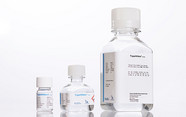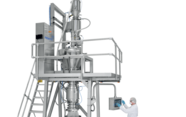The Challenges Behind Amgen’s Rare Disease Treatment
We speak with experts from Amgen and Henry Ford Health about the development and approval of Uplizna for IgG4-related disease.
| 9 min read | Interview

“We're excited about this approval, which marks a turning point for IgG4-RD patients who, until now, had no FDA-approved treatment options.”
The FDA approved Amgen’s Uplizna (inebilizumab-cdon) in April, making it the first and only treatment for Immunoglobulin G4-related disease (IgG4-RD), a rare autoimmune condition. The chronic disease causes inflammation and scarring across multiple organs, including the pancreas, kidneys, and liver.
In a pivotal clinical trial, Uplizna reduced the risk of disease flares by 87 percent compared to placebo. We spoke with Dan Cimbora, senior scientific director, Amgen, and Alireza Meysami, Division Head of Rheumatology, Henry Ford Health, to learn more.

Dan Cimbora
What were some of the unique challenges you encountered when developing a therapy specifically for IgG4-RD, given its rarity and diverse clinical manifestations?
Dan Cimbora: One of the biggest challenges was designing the MITIGATE trial, which is the first randomized, placebo-controlled trial in IgG4-RD. We were in untrodden territory. There were no other studies to help guide our trial design, so we collaborated with a panel of global experts in the disease to design a feasible study. Together, we selected measurable endpoints that were both clinically meaningful and satisfied the regulators we consulted during the pre-IND process.
Using time to first disease flare after randomization as our primary endpoint meant creating a set of novel, organ-specific diagnostic criteria covering each organ potentially involved in IgG4-RD to define what constituted an IgG4-RD flare, as there were no widely accepted definitions at the time. Given the potential variability in flare manifestation based on the organ involved, we also established a blinded, independent central review of all suspected flares to ensure uniform application of diagnostic criteria.
Opening new trial sites and recruiting patients during the height of COVID in 2020 was another hurdle, but perhaps not as great as the impacts of very limited awareness of IgG4-RD among healthcare professionals, and the lack of ICD-10 code that would have enabled more efficient patient identification and referral (an ICD-10 code was established in 2023).
Despite these challenges, we were able to establish a robust and reliable assessment for identifying an IgG4-RD flare that can be utilized in future trials and successfully demonstrated strong efficacy with Uplizna in IgG4-RD.
How did your understanding of the pathophysiology of IgG4-RD inform the selection of inebilizumab as a candidate therapeutic?
DC: Our understanding that B cells are central to the pathogenesis of IgG4-RD significantly influenced our selection of inebilizumab as a promising therapeutic candidate. Research and clinical observations have shown that affected tissues in IgG4-RD patients are characterized by infiltrations of lymphocytes and plasma cells, with many cells expressing IgG4 and CD19. More recent studies have found the B cells at the sites of these lesions are secreting profibrotic and proinflammatory factors – they are driving inflammation, fibrosis, and organ damage.
In IgG4-RD, B cells can also act as antigen-presenting cells. All the proteins that exist in the “protein soup” environment of an IgG4 lesion can be picked up by B cells and be presented to and engage with T cells, which can start attacking tissue as well. That knowledge, coupled with clinical reports that pointed to the efficacy of B-cell depletion as a beneficial therapeutic avenue, gave us confidence to go straight into a phase III study.

Alireza Meysami
What is the rationale for targeting CD19 in IgG4-RD? How does it compare to other potential B cell targets?
Alireza Meysami: Targeting CD19 in IgG4-RD is based on the key role B cells play in driving the disease. CD19-expressing B cells are thought to drive inflammatory and fibrotic processes, interacting with other immune cells to contribute to disease activity. CD19 expression appears earlier than CD20 expression in B-cell development and persists later, notably on plasmablasts and some plasma cells. Therefore, therapies targeting CD19 are effective in the treatment of IgG4-related disease and may offer advantages over anti-CD20 strategies by means of targeting ranges of B cells that drive IgG4-related disease.
How did biomarker data influence patient stratification or endpoint selection during clinical trials for Uplizna in this indication?
DC: Biomarker data played a valuable, supportive role, rather than a primary one, in patient stratification and endpoint selection for the MITIGATE trial. Both the primary and key secondary endpoints were based on meaningful clinical outcomes, such as time to first flare and corticosteroid-free remission, rather than biomarker data.
While the field generally accepts that peripheral B cells and serum IgG4 levels tend to rise before a disease flare in many patients, these biomarkers were not used as primary determinants for patient eligibility or stratification. Instead, eligibility was focused on clinical criteria, such as disease activity and organ involvement. While we did include endpoints related to both B cells and IgG4 levels, they were not used to demonstrate clinical benefit of the treatment and instead provided supportive evidence of the drug's mechanism.
The study observed significant B-cell depletion and a decrease in IgG4 levels in patients receiving the active drug compared to the placebo group. These biomarker findings complement the clinical efficacy data and enhance our understanding of Uplizna’s impact.
What insights have you gained about B cell depletion and disease relapse in IgG4-RD that might shape future drug development in this space?
DC: Research dedicated to the function of B cells has shown that they can cause faulty immune reactions, leading to inflammation when dysregulated.
This inspired the development of an engineered antibody therapy designed to precisely bind to and target B cells expressing CD19+, including plasmablasts and some plasma cells. CD19 is a cell surface protein that is specifically expressed across the B-cell lineage, and Uplizna selectively targets CD19+ B cells. This allows it to deplete not only “middle stage” B cells, but also those earlier and later in the development pathway that may escape therapies targeting other cell surface proteins such as CD20.
Targeting CD19 provides effective B-cell depletion while sparing other types of immune cells, such as T cells. Glycoengineering enhances the ability of Uplinza to target CD19+ plasmablasts and some plasma cells that are believed to drive IgG4-RD disease activity. During development, the fragment crystallizable region of Uplizna was modified in a way to specifically remove a fucose sugar molecule, allowing for efficient binding of effector natural killer cells and effective B-cell depletion without the need for dose adjustments.
AM: Uplizna is a humanized, afucosylated monoclonal antibody that selectively targets CD19+ B cells such as plasmablasts and some plasma cells, which are believed to drive IgG4-RD inflammation and fibrosis. This allows the drug to deplete not only mature B cells but also those earlier in the development pathway. It was promising to see that findings from the phase III MITIGATE trial showed Uplizna delivered an 87 percent reduction in the risk of adjudicated IgG4-RD flares versus placebo.
What implications might this have for other autoimmune conditions?
AM: B cell-directed therapies have already transformed the landscape of autoimmune disease management by reducing antibody production, antigen presentation, and cytokine-mediated inflammation. The efficacy of Uplizna in IgG4-RD and NMOSD provides proof-of-concept that B cell depletion via CD19 targeting may be beneficial across other B cell–driven autoimmune conditions.
Its steroid-sparing potential is particularly attractive, as long-term glucocorticoid use can lead to significant comorbidities such as diabetes, osteoporosis, and infection risk. The ability of inebilizumab to maintain disease control without chronic steroid use could be a major step forward in improving quality of life for patients with chronic autoimmune diseases. In the MITIGATE trial, participants who received inebilizumab required lower cumulative glucocorticoid exposure (excluding the eight-week taper in all participants) to induce remission and maintain disease control during the treatment period than participants who received placebo. The trial also showed that 90 percent of participants in the inebilizumab group discontinued glucocorticoid treatment entirely during the treatment period, as compared with 37 percent in the placebo group.
Are there any immunologic or molecular signatures you identified during development that could potentially serve as predictors of treatment response in IgG4-RD?
AM: The MITIGATE trial focused primarily on clinical endpoints, but several immunologic markers were explored to better understand treatment response. Notably, CD19+ B cell depletion accompanied clinical response, suggesting it could serve as a useful pharmacodynamic marker.
Reductions in serum IgG4 levels were also correlated with favorable clinical outcomes, indicating that serum IgG4 concentration could be explored as a predictive biomarker. However, the heterogeneity of IgG4-RD and individual patient variability mean that no single marker is sufficient in isolation. Ongoing studies are needed to validate a combination of markers – such as B cell subset profiling, IgG4 levels, and tissue-based signatures – to optimize individualized treatment strategies.
Does the success of Uplizna in IgG4-RD inform or accelerate any other ongoing programs you’re pursuing in autoimmune diseases?
DC: We're excited about this approval, which marks a turning point for IgG4-RD patients who, until now, had no FDA-approved treatment options. This second indication cements the role of Uplizna in treating immune-mediated diseases and fuels our momentum, with further studies underway to explore the potential of helping patients living with other immune-mediated conditions.
Filing activities are currently underway for the approval of Uplizna to treat generalized myasthenia gravis. A recent study presented at the American Academy of Neurology Annual Meeting and published in the New England Journal of Medicine demonstrated significant efficacy of Uplizna in the overall population of generalized myasthenia gravis – including acetylcholine receptor autoantibody-positive (AChR+) and muscle-specific kinase autoantibody-positive (MuSK+) – at Week 26 and durable and sustained efficacy of Uplizna in patients with AChR+ generalized myasthenia gravis with two doses a year, following an initial loading dose.
Uplizna is also approved for neuromyelitis optica spectrum disorder by many regulatory bodies, including the FDA, the EMA, Japan's PMDA, Health Canada and the Brazilian Health Regulatory Agency, among others.
What are your next priorities for real-world data collection or post-marketing studies, especially concerning long-term safety or disease modification in this population?
DC: The MITIGATE trial, on which the FDA approval was based, includes a three-year open-label treatment period to collect long-term safety and efficacy data, and a two-year safety follow-up period after Uplizna discontinuation to understand the dynamics of B cell recovery and immunoglobulin level.
The long-term open-label data will inform if and how well the efficacy that we observed during the pivotal trial is maintained based on reduction of flare risk, reduction in annualized flare rate, and reduction in glucocorticoid use in addition to the proportion of patients achieving flare-free complete remission. This will allow us to compare patient outcomes year-over-year and understand how Uplizna modifies the trajectory of IgG4-RD.



















